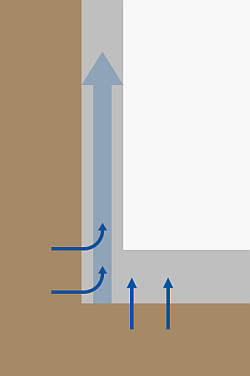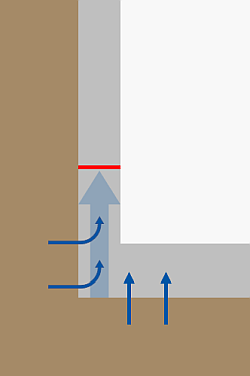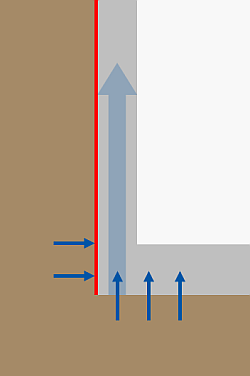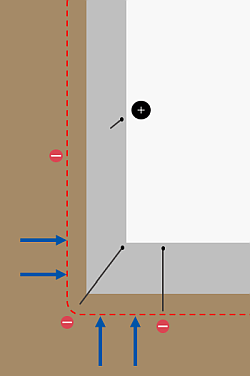Wet basement, what to do?
Haustrocknung.ch GmbH, based in the canton of Bern, has specialized in wet basements since 2010. In this guide, you will find out why cellars get damp and what you can do about it.

Causes and solutions for damp cellars
Core statements
- First have damp cellars inspected by building experts and only start remedial measures when it is clear why the cellar is damp.
- The use of building dryers can exacerbate the moisture problem and lead to damage to the building fabric.
- Electrophysical wall dehumidification can be installed cost-effectively and dries the building fabric right down to the cellar floor.
1. Why is the cellar damp?
The most common causes of damp cellars are capillary rising damp in the walls, condensation, faulty installations in the house and damage to the building envelope. Pressing damp, on the other hand, is rarely the problem. In most cases, several sources of moisture overlap.
For this reason, it is recommended, Building experts in order to identify the actual causes of moisture. We explain the individual causes in detail in the following sections.
Alongside condensation, this effect is probably the most common cause of damp in basements. The actual reason for rising damp is not the leakiness of the cellar wall, but the physical properties of the building fabric. The naturally negatively charged wall promotes the rising damp within the wall.
Moisture condenses on cold wall surfaces, where it can cause consequential damage over time, such as mold infestation. Condensation is often caused by incorrect ventilation: Warm air can absorb significantly more moisture than cold air and releases the moisture onto the wall as condensation.
Therefore, ventilation should only take place when it is cooler outside than inside. Otherwise the warm air will bring moisture into the house, which will then condense on the cooler wall surfaces, similar to the outside of a cool glass bottle.
Poor installations are unfortunately common. These include external rainwater systems such as water barrels, gutters, downpipes and flat roofs; the poor condition of bricks, stones, mortar, wall bases, plaster, weatherproof paints and silicone joints; weak points in wall construction such as cracks in brickwork or copings; structures adjacent to the brickwork that conduct water to the brickwork, including leaking windows and doors; the location and condition of vents; chimneys and rain deflectors; mechanical or chemical damp proof courses.
Pressing sources of moisture are the exception rather than the rule. They are usually a sign that the building was erected in an unfavorable location. Sources of pressing damp include pressing slope water, springs or water veins in the vicinity of the building and a groundwater level that periodically rises.
2. How can wet basements be renovated?
To successfully renovate a damp cellar, the cause of the damp must be eliminated and the building fabric dried out: Condensation can be remedied with intelligent basement ventilation. In some cases, even targeted shock ventilation can be sufficient. If water penetrates the building fabric through cracks and holes in the building envelope, this damage must be repaired.
If moisture rises in the capillaries of the cellar wall, there is the option of a mechanical or electrophysical horizontal barrier.
In the case of a pressing source of moisture, the only thing that often helps is a large-area vertical barrier in combination with a ring drainage system that drains the water away from the house.
Principle: Injecting a sealant and installing a watertight mechanical or electrophysical barrier layer prevents moisture from rising inside the cellar wall in the future. Above the horizontal barrier, the wall becomes permanently dry.
Advantages: Water can no longer rise higher than the horizontal barrier.
Disadvantages: With mechanical horizontal barriers, the diameter of the cellar wall must be completely traversed along the entire length of the wall. This is a far-reaching intervention in the building fabric with a high risk of consequential damage.
The areas below the horizontal barrier, such as the cellar floor and the foundations, remain damp despite the horizontal barrier. The horizontal barrier is complex and correspondingly cost-intensive.
If, for example, the wall on a slope is exposed to moisture above the horizontal barrier, the horizontal barrier must be supplemented with a vertical barrier.
Procedure: Injection method, wall sawing method, wall replacement method, sheet metal impact method, electrophysical wall dehumidification (see next paragraph)
Principle: A large-area waterproof barrier layer, such as a bitumen coating or slurry render, seals the cellar wall from the outside or inside.
Advantages: The entire sealed surface is protected from penetrating moisture.
Disadvantages: The cellar wall can continue to become damp from below. With an internal vertical barrier, the wall remains damp on the outside.
With a waterproof barrier layer, the wall can no longer "breathe". This preserves the moisture in the wall and can increase the risk of mold in the building.
External vertical barriers are cost-intensive because the entire basement wall has to be exposed.
Procedure: Bituminous coatings (black tank); mineral waterproofing slurries; waterproofing membranes made of bitumen, rubber, PVC or polyethylene (K-tub); surface and curtain injections
Principle: By its very nature, water always flows towards the negatively charged pole. In a tree, for example, the water flows from the positively charged roots to the very top, where the negatively charged leaves are.
Electroosmosis: The installation of a low permanent electrical voltage in the damp cellar wall prevents moisture from penetrating the building fabric. The residual moisture evaporates over time so that the cellar wall and foundations become permanently dry down to the cellar floor.
Advantages: The cellar can be renovated from the inside. Only minor structural interventions in the building envelope are required. Electrophysical cellar dehumidification is a very cost-effective method.
Disadvantages: Not all systems on the market are scientifically recognized. Any damage to the building envelope must first be repaired. In the case of a pressing source of moisture, electrophysical cellar dehumidification must be supplemented with other sealing methods.

Rising damp

Principle of the horizontal barrier

Principle of the vertical barrier

Electrophysical barrier
3. What are common mistakes in damp cellars?
Common mistakes in the renovation of damp cellars are inadequate analysis of the causes of damp or the prolonged use of building dryers.
The use of powerful building dryers can exacerbate the moisture problem in the event of penetrating moisture. This is because the moisture in the cellar wall is in equilibrium with the moisture in the surrounding soil. If more moisture evaporates on the inside of the cellar wall due to the building dryer, the wall draws in more moisture from the outside.
Together with the moisture, mineral salts enter the masonry. On the one hand, this salinization of the wall means that the wall can absorb even more moisture. On the other hand, the dissolved salts increase in volume as they dry. Over time, this leads to flaking and major damage on the inside of the wall.
4. How much does it cost to renovate a wet basement?
Electrophysical dehumidification with DRYMAT® costs around CHF 15,000 to 20,000 for a detached house with a floor area of 60 square meters. This estimate includes all stages of the job, from the analysis and installation to the follow-up measurement 18 months after installation. In addition, operating costs of around 50 francs are incurred per year. No maintenance work is required. You get a 10-year guarantee.
In comparison, the cost of draining the same property using a drainage system is closer to 45,000 to 60,000 francs. The costs for the earthworks are particularly significant.
Electrophysical drying with DRYMAT® is risk-free for people and the building fabric and does not interfere with the building statics. As the installation of DRYMAT® can be reversed, the process is compatible with the protection of historical monuments. The DRYMAT® system works according to scientifically recognized principles and is certified in accordance with ÖNORM B 3355-2.
5. Summary: What to do with a damp cellar?
First have damp cellars inspected by building experts to determine the causes of the damp. Only start with remedial measures once it is clear why the cellar is damp.
In many cases, rising damp in the capillaries of the cellar wall is the cause. In this case, electrophysical cellar dehumidification with DRYMAT® is a cost-effective solution with a certified guarantee of success. Compared to mechanical horizontal barriers, DRYMAT® has virtually no risk of consequential damage and comes with a 10-year guarantee.
If condensation is the cause of moisture, intelligent basement ventilation systems can help to minimize the risk of radon. In the case of a pressing source of moisture, the only thing that often helps is a large-area vertical barrier in combination with ring drainage that drains the water away from the building.

Contact us without obligation
Do you have any further questions or may we prepare an offer for you?
Get in touch with us without obligation. We look forward to your inquiry!
Get in touch with us without obligation. We look forward to your inquiry!
Tobias Bayer
Managing Director


